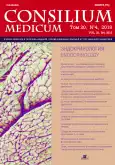Семь этиологических факторов становления синдрома резистентности к инсулину
- Авторы: Титов В.Н.1
-
Учреждения:
- ФГБУ «НМИЦ кардиологии»
- Выпуск: Том 20, № 4 (2018)
- Страницы: 68-74
- Раздел: Статьи
- URL: https://journals.rcsi.science/2075-1753/article/view/95044
- DOI: https://doi.org/10.26442/2075-1753_2018.4.68-74
- ID: 95044
Цитировать
Полный текст
Аннотация
Ключевые слова
Полный текст
Открыть статью на сайте журналаОб авторах
Владимир Николаевич Титов
ФГБУ «НМИЦ кардиологии»
Email: n_titov@mail.ru
д-р мед. наук, проф., зав. лаб. клинической биохимии липидного обмена 121552, Russian Federation, Moscow, ul. 3-ia Cherepkovskaia, d. 15a
Список литературы
- Тейлор Д. Здоровье по Дарвину. Почему мы болеем и как это связано с эволюцией. М.: Альпина Паблишер, 2016
- Irawati D, Mamo J, Dhaliwal S.S et al. Plasma triglyceride and high density lipoprotein cholesterol are poor surrogate markers of pro-atherogenic chylomicron remnant homeostasis in subjects with the metabolic syndrome. Lipids Health Dis 2016; 15 (1): 169. https://search.crossref.org/funding?q=501100001797..4
- Титов В.Н. Клиническая биохимия. Курс лекций. М.: ИНФРА-М, 2017.
- Botham K.M, Wheeler-Jones C.P. Postprandial lipoproteins and the molecular regulation of vascular homeostasis. Prog Lipid Res 2013; 52 (4): 446-64.
- Zakiev E.R, Nikiforov N.G, Orekhov A.N. Cell-Based models for development of antiatherosclerotic therapies. Biomed Res Int 2017; 2017: 5198723. https://www.ncbi.nlm.nih.gov/ pubmed/28286766
- Уголев А.М. Естественные технологии биологических систем. Л.: Наука, 1987.
- Scheithauer T.P, Dallinga-Thie G.M, de Vos W.M et al. Causality of small and large intestinal microbiota in weight regulation and insulin resistance. Mol Metab 2016; 5 (9): 759-70.
- Bullon P, Marin-Aguilar F, Roman-Malo L. AMPK/Mitochondria in metabolic diseases. EXS 2016; 107: 129-52.
- Goodpaster B.H, Sparks L.M. Metabolic flexibility in health and disease. Cell Metab 2017; 25 (5): 1027-36.
- Garg S.G, Martin W.F. Mitochondria, the cell cycle, and the origin of sex via a syncytial eukaryote common ancestor. Genome Biol Evol 2016; 8 (6): 1950-70.
- Jin E.S, Beddow S.A, Malloy C.R, Samuel V.T. Hepatic glucose production pathways after three days of a high-fat diet. Metabolism 2013; 62 (1): 152-62.
- Buldak L, Dulava-Buldak A, Labuzek K, Okopien B. Effects of 90-day hypolipidemic treatment on insulin resistance, adipokines and proinflammatory cytokines in patients with mixed hyperlipidemia and impaired fasting glucose. Int J Clin Pharmacol Ther 2012; 50 (11): 805-13.
- Okuyama H, Langsjoen P.H, Ohara N et al. Medicines and vegetable oils as hidden causes of cardiovascular disease and diabetes. Pharmacology 2016; 98 (3-4): 134-70.
- Титов В.Н. Изоферменты стеарил-коэнзим А-десатуразы и действие инсулина в свете филогенетической теории патологии. Олеиновая жирная кислота в реализации биологической функции трофологии и локомоции. Клин. лабораторная диагностика. 2013; 11: 16-26
- Лисицын Д.М., Разумовский С.Д., Тишенин М.А., Титов В.Н. Кинетические параметры окисления озоном индивидуальных жирных кислот. Бюллетень экспериментальной биологии и медицины. 2004; 138 (11): 517-9.
- Capurso C, Capurso A. From excess adiposity to insulin resistance: the role of free fatty acids. Vascul Pharmacol 2012; 57 (2-4): 91-7.
- Jeschke M.G, Boehning D. Endoplasmic reticulum stress and insulin resistance post-trauma: similarities to type 2 diabetes. J Cell Mol Med 2012; 16 (3): 437-44.
- Салтыкова М.М. Адаптация к холоду как средство усиления антиоксидантной защиты. Рос. физиологич. журн. 2017; 103 (7): 712-26.
- Kraegen E.W, Cooney G.J, Ye J, Thompson A.L. Triglycerides, fatty acids and insulin resistance - hyperinsulinemia. Exp Clin Endocrinol Diabetes 2001; 109 (4): S516-S526.
- Valera L.M, Ortega A, Bermudez B et al. A high-fat meal promotes lipid-load and apolipoprotein B-48 receptor transcriptional activity in circulating monocytes. Am J Clin Nutr 2011; 93 (5): 918-25.
- Filipou A, Teng K.T, Berry S.E, Sanders T.A. Palmitic acid in the sn-2 position of dietary triacylglycerols does not affect insulin secretion or glucose homeostasis in healthy men and women. Eur J Clin Nutr 2014; 68 (9): 1036-41.
- Connor W.E, Lin D.S, Colvis C. Differential mobilization of fatty acids from adipose tissue. J Lipid Res 1996; 37: 290-8.
- Longo G, Soto A.M. Why do we need theories? Prog Biophys Mol Biol 2016; 122 (1): 4-10.
- Li L.O, Grevengoed T.J, Paul D.S et al. Compartmentalized acyl-CoA metabolism in skeletal muscle regulates systemic glucose homeostasis. Diabetes 2015; 64 (1): 23-35.
- Agren J.J, Ravandi A, Kuksis A, Steiner G. Structural and compositional changes in very low density lipoprotein triacylglycerols during basal lipolysis. Eur J Biochem 2002; 269 (24): 6223-32.
- Bei F, Jia J, Jia Y.Q. et al. Long-term effect of early postnatal overnutrition on insulin resistance and serum fatty acid profiles in male rats. Lipids Health Dis 2015; 14: 96-109.
- Титов В.Н., Малышев П.П., Амелюшкина В.А. и др. Действие статинов: активация липолиза и поглощения инсулинозависимыми клетками липопротеинов очень низкой плотности, повышение биодоступности полиеновых жирных кислот и понижение холестерина липопротеинов низкой плотности. Клин. лабораторная диагностика. 2015; 10: 4-12.
- Van Capalleveen J.C, Bernelot Moens S.J, Yang X et al. Apolipoprotein C-III levels and Incident coronary artery disease risk: the EPIC-Norfolk prospective population study. Arterioscler Thromb Vasc Biol 2017; 37 (6): 1206-12.
- Drouin-Chartier J.P, Tremblay A.J, Hogue J.C et al. C-reactive protein levels are inversely correlated with the apolipoprotein B-48-containing triglyceride-rich lipoprotein production rate in insulin resistant men. Metabolism 2017; 68: 163-72.
- Титов В.Н., Салтыкова М.М. Становление филогенеза функции метаболизма подкожных инсулинзависимых адипоцитов. Этиологический фактор и патогенез ожирения как метаболической пандемии. Клин. лабораторная диагностика. 2017; 62 (1): 4-12.
- Jesckhe M.G, Finnerty C.C, Herndon D.N et al. Severe injury is associated with insulin resistance, endoplasmic reticulum stress response, and unfolded protein response. Ann Surg 2012; 255 (2): 370-8.
Дополнительные файлы






